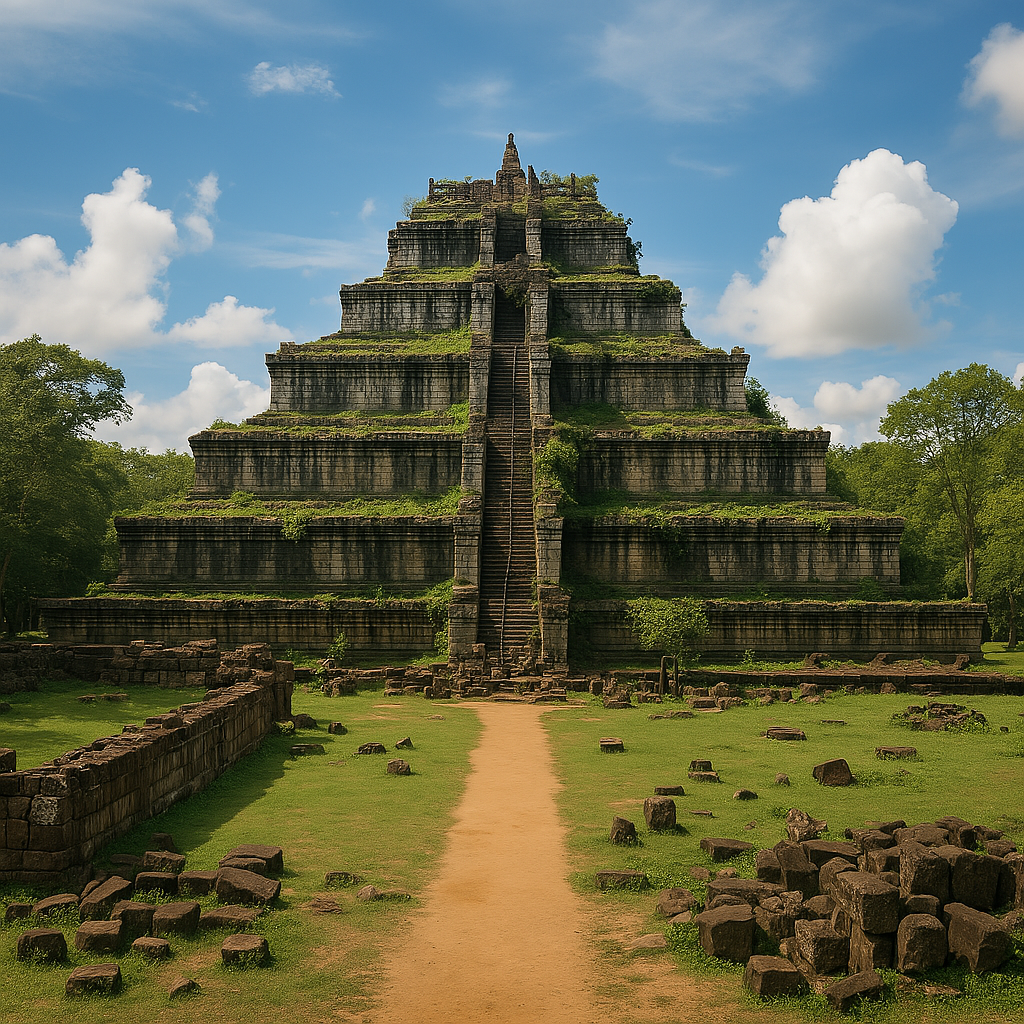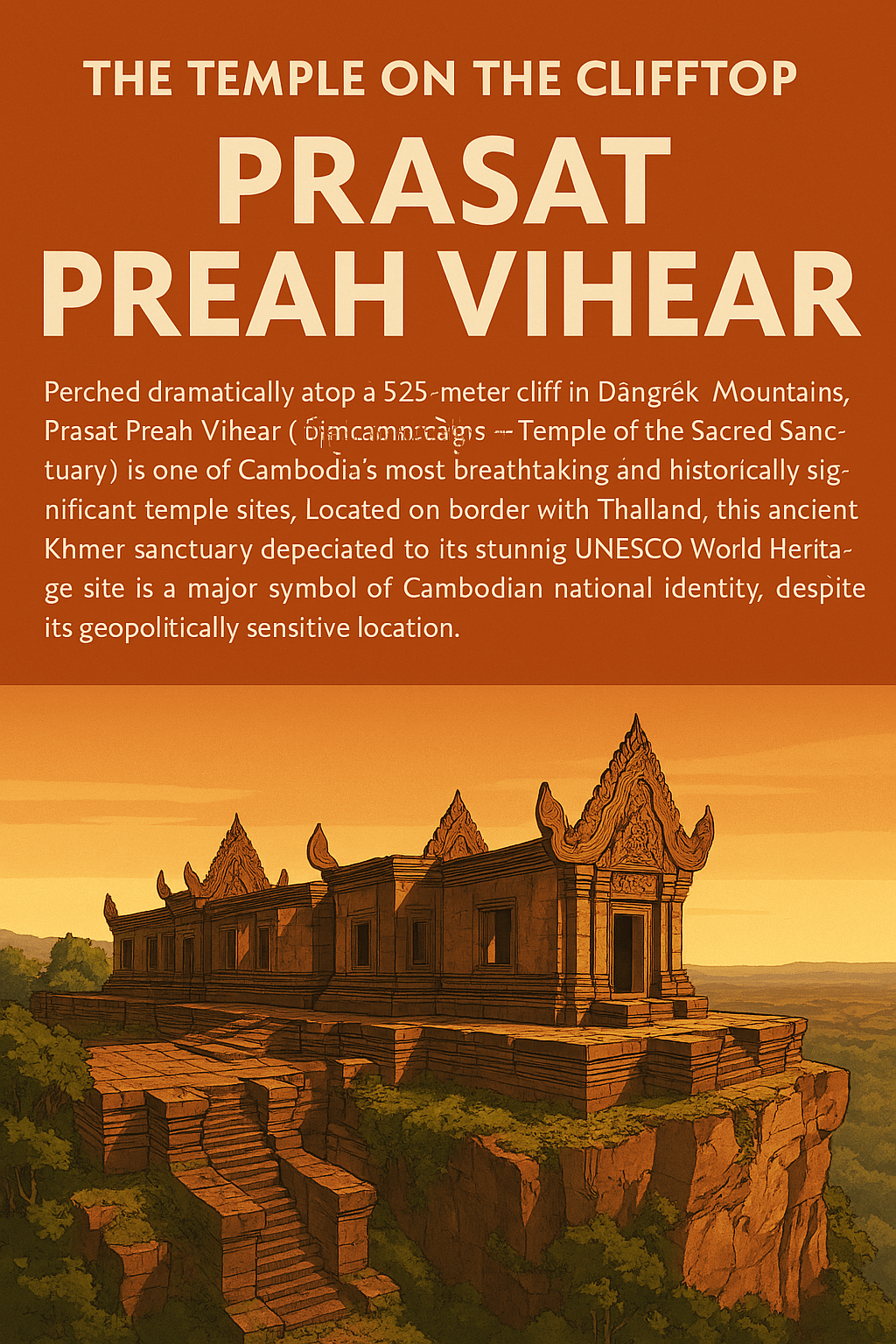Deep within the forests of northern Cambodia lies Koh Ker, a vast and enigmatic archaeological site that served as the powerful capital of the Khmer Empire for a brief but brilliant period in the 10th century. Dominated by a unique seven-tiered pyramid temple, Prasat Thom (Prang), Koh Ker offers a fascinating contrast to the more familiar architecture of Angkor Wat and Angkor Thom. Long overshadowed by its successors and reclaimed by the jungle, this ‘forgotten capital’ was inscribed as a UNESCO World Heritage site in September 2023, marking a new chapter in its recognition and preservation, and beckoning adventurous travelers seeking to explore beyond the main Angkorian circuit.
A Rival Capital: History of Koh Ker (Lingapura)

For a short but intense period, Koh Ker reigned supreme. Around 928 AD, King Jayavarman IV broke with tradition and moved the Khmer capital nearly 100 kilometers northeast from the established Angkor region to this relatively remote area, then known as Lingapura (“City of the Linga”) or Chok Gargyar. During his reign (c. 928-941 AD), Jayavarman IV launched an ambitious building program, transforming Koh Ker into a major political and religious center intended to rival Angkor. However, shortly after his death, his successor returned the capital to the Angkor area around 944 AD. Koh Ker was largely abandoned, its magnificent structures gradually surrendered to the surrounding forest for nearly a millennium.
The Pyramid of Cambodia: Prasat Thom and the Prang

The undisputed centerpiece of Koh Ker is Prasat Thom, a temple complex whose most striking feature is the Prang – an imposing seven-tiered sandstone pyramid rising approximately 36 meters high. This structure is unique in Khmer architecture:
- Form: Unlike the more gently sloped temple-mountains typical of Angkor (like Bakheng or Angkor Wat), the Koh Ker Prang is a steep-sided pyramid, more visually akin to Mesoamerican structures (though architecturally distinct).
- Symbolism: It almost certainly represented the mythical Mount Meru, home of the gods, but its stark, dominant form offered a different interpretation compared to other Khmer temple-mountains.
- Access: A (now modern and safer) wooden staircase allows visitors to ascend to the summit, offering panoramic views over the forest canopy and surrounding temple ruins (always check current accessibility).
City of the Linga: Sacred Symbolism

Koh Ker’s ancient name, Lingapura, points to its intense dedication to the Hindu god Shiva, worshipped primarily through the linga, a phallic symbol representing Shiva’s creative energy. The site is renowned for evidence of unusually large lingas. Legends and archaeological studies suggest a truly colossal linga may have once stood atop the Prang, symbolizing Jayavarman IV’s supreme authority and his divine connection to Shiva. Numerous other lingas and pedestals (yonis) have been found throughout the complex, underscoring its focus as a major Shaivite center.
A Realm Reclaimed by Jungle: The Lost City

Koh Ker is not just the pyramid; it is a sprawling archaeological landscape covering roughly 80 square kilometers, dotted with the ruins of numerous temples, shrines, libraries, and large reservoirs (barays). Estimates suggest over 180 sanctuaries may exist within the wider area, many still unrestored and enveloped by jungle. Notable subsidiary temples easily accessible within the main group include:
- Prasat Krahom: The “Red Temple,” named for its imposing structure built primarily of red brick, located just before the Prang.
- Prasat Bram: The “Temple of Five Towers,” famous for the large strangler fig trees growing dramatically through its laterite towers, creating an iconic image of nature reclaiming ancient stone.
- Prasat Chen: The “Chinese Temple,” featuring intricate carvings and well-preserved lintels. Exploring Koh Ker offers a palpable sense of discovering a ‘lost city’ emerging from the wilderness.
Challenges and Preservation: Protecting Koh Ker

As a remote site, Koh Ker faced significant challenges for centuries:
- Looting: The site suffered extensive looting, especially during Cambodia’s conflict years and the subsequent decades. Many exceptional statues unique to the Koh Ker style were trafficked abroad, although international cooperation is leading to the gradual repatriation of some pieces.
- Natural Decay: Encroaching jungle vegetation, weather exposure, and collapsing structures require constant conservation efforts.
- Landmines: The area was heavily mined during the civil war. While the main temple group and access routes have been thoroughly cleared and are safe for tourists, straying far from marked paths is strongly discouraged.
- UNESCO Recognition (September 2023): Koh Ker’s inscription as a World Heritage site is a major milestone. It brings heightened international attention, potential for increased funding, and mandates robust management plans by Cambodian authorities (Ministry of Culture and Fine Arts/APSARA National Authority) and international partners for research, conservation, demining in wider areas, sustainable tourism development, and community engagement.
An Explorer’s Destination: Why Visit Koh Ker?

For travelers seeking experiences beyond the main Angkor circuit, Koh Ker offers compelling reasons to visit (as of April 2025):
- Unique Architecture: The seven-tiered Prang is unlike any other temple structure in Cambodia.
- Off-the-Beaten-Path Feel: Located about a 2-3 hour drive from Siem Reap, it receives significantly fewer visitors than Angkor Wat or Bayon, offering a more tranquil and adventurous atmosphere.
- ‘Lost City’ Ambiance: The numerous temples scattered through the forest provide a sense of exploration and discovery.
- Photogenic Ruins: Sites like Prasat Bram offer dramatic photo opportunities of nature intertwined with ancient architecture.
Conclusion
Koh Ker stands as a unique and powerful testament to a distinct period in Khmer history, when the empire’s capital briefly shifted, resulting in an architectural style and scale specific to this site. Dominated by its enigmatic pyramid and surrounded by jungle-clad ruins, it offers a compelling glimpse into the ambition of Jayavarman IV and the artistic vigor of the 10th century. Recently recognized by UNESCO, Koh Ker is poised for greater international appreciation and enhanced protection. For visitors willing to venture beyond the familiar wonders of Angkor, Koh Ker provides an unforgettable journey into Cambodia’s ‘forgotten capital,’ a site of immense historical importance and adventurous allure, significant to Cambodians throughout the nation, including those in Battambang.





